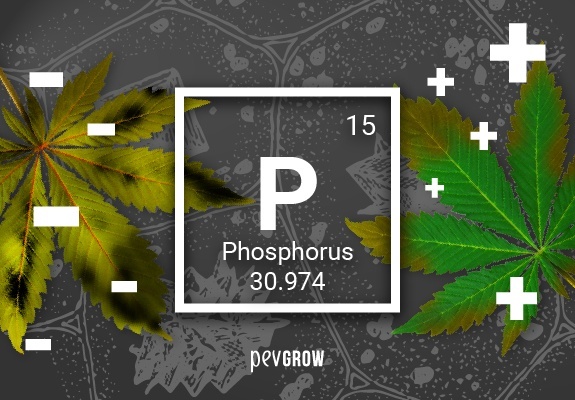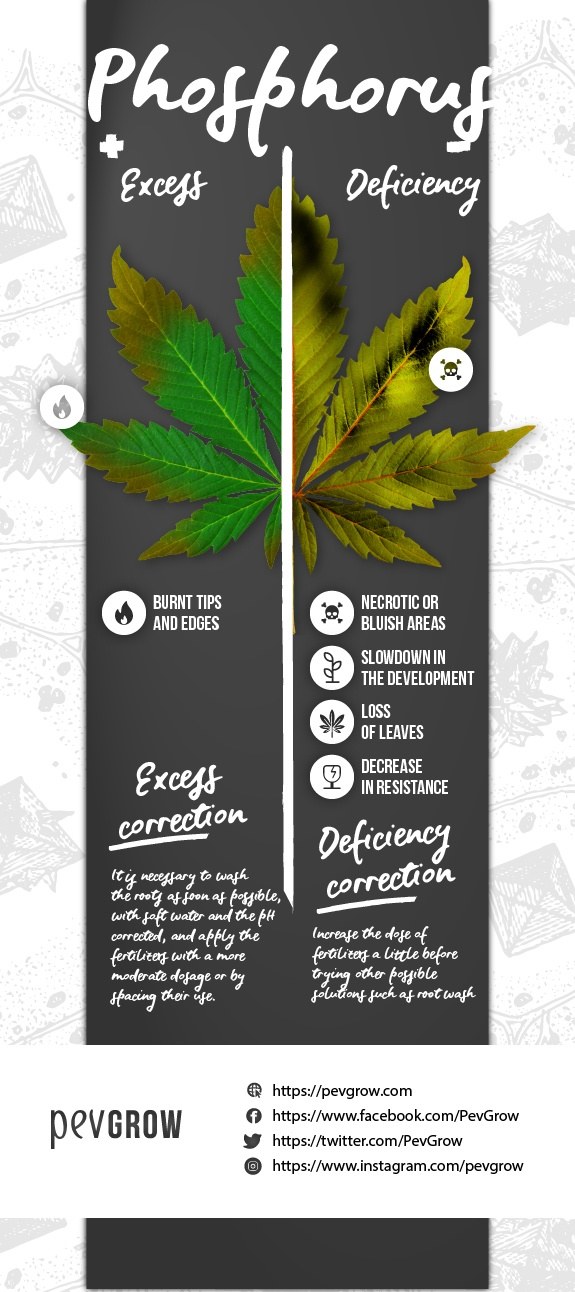

In constant struggle for the regulation of cannabis, mainly in the medicinal field.
10-12-2021 12:00:18 - Updated: 10 December, 2021
Phosphorus (P) is one of the 3 essential macro elements in the feeding of marijuana plants, its importance is vital and when plants can not assimilate it properly because of deficiencies, excesses, or blockages of this nutrient, the most normal thing is that there is a loss in the total production of the grow. So that this problem never happens in your grow tent or in your outdoor garden, we have created this article where we will review its functions, the best way to use it, and the mistakes that are often made, Interesting right? Well, I won’t make you wait any longer…
⭐ The importance of phosphorus in cannabis crops
After nitrogen and potassium, phosphorus is the most important element of all the nutrients that marijuana plants consume from the ground. There are several phases of the cultivation of this plant where phosphorus plays a very important role, such as in the germination of the seeds, the development of the root system, the vegetative growth, and especially during the flowering and fattening of the buds.
A good part of the energy that the plant accumulates thanks to the photosynthesis process, does so in the form of phosphorus, which is later used to perform a series of fundamental functions, such as the ones you can see below :
- Formation of Phytin as a phosphorus store for the germination phase
- rooting and tillering of plants and cuttings
- Enhances theImproves nitrogen assimilation during the vegetative growth phase
- Intervenes in photosynthesis and other processes such as respiration, synthesis, and the breakdown of fats, proteins, and carbohydrates
- Form part of the enzymes responsible for transporting energy through the plant
- It is an essential component of the cell membrane
- An essential component in the flowering and maturation of buds
⛳ Why does a lack of phosphorus appear in marijuana plants?
The lack of phosphorus can appear for different reasons, either because there is not enough availability of it, because of the blockage caused by the excess of other elements, by an excess of salts in the substrate, or by an incorrect PH in the irrigation water or from the ground.
The plant takes phosphorus and other nutrients from the earth until they are exhausted, and in crops that use an inert substrate such as coconut fiber or arlite, or others that do not directly have soil such as aeroponic, all the phosphorus must be given through the nutrient solution of irrigation. An excess of salts in the substrate prevents the correct assimilation of all the nutrients present in the soil, as does too high or too low a PH in the substrate or irrigation water.
✨ Visible symptoms of a phosphorus deficiency in cannabis plants
When a plant suffers from a phosphorus deficiency, it shows it in the stems, petioles, and older leaves, since it is a mobile element and when it is missing to form new shoots it takes it from the reserves of the oldest leaves. On the stems somecan appear colored lines vertically, the petioles turn purple or reddish, and appear on the leaves’ necrotic or bluish areas. These colorations are due to the concentration of anthocyanins and chlorophyll caused by the accumulation of sugars.
Other consequences of the lack of phosphorus in marijuana plants are a slowdown in the rate of development, the loss of leaves, a poor and weak root system, a greater propensity to diseases, and a decrease in resistance to cold and other types of stress.
👌 Phosphorus deficiency in flowering
The biggest problems caused by a phosphorus deficiency in marijuana crops occur during the flowering stage, since in this phase it is essential for a correct formation of the buds. Sometimes the biggest problem is caused by an accumulation of salts in the substrate, collapsed from so many fertigation that we give it until then.
One way to avoid this is by transplanting to a larger capacity pot just before changing the photoperiod to flowering, so that the roots have more space to grow and the substrate is as clean as possible of salts before reaching the most critical moment. of the crop. In this way, the plant will have food in the soil and you can delay the application of high doses of fertilizers until approximately the fourth week of flowering.
📲 Phosphorus for growing marijuana
The “type soilAll Mix“has enough food to last for about 1 month without the need to add fertilizers, but if you work with “Light Mix” type substrate you will have to start fertigation after approximately 15 days, and this must be done. Take it into account so that the lack of phosphorus does not appear in your plants. The non-specific substrate for cannabis is not advisable in this case, sometimes trying to save a few euros all you get is a horrible harvest, so I strongly recommend that you always use special marijuana soil from a well-known brand.
The special liquid fertilizers for cannabis indicate the amount of nitrogen, phosphorus, and potassium they contain (NPK) and usually also carry a balanced distribution of secondary nutrients and microelements. Their composition varies depending on the phase of the crop, since in vegetative growth they need more nitrogen, and during flowering they consume more phosphorus and potassium.
🚀 How to correct a phosphorus deficiency in cannabis plants?
If you use fertilizers and substrate for cannabis from well-known brands, follow their nutrition table, irrigate with soft water, and adjust the PH, it is very difficult for a lack of phosphorus or any other element to arise, in this there are no secrets. But if you are unlucky enough to suffer from this problem, the first thing you have to see is if you are doing all this right, look at the status and expiration date of the products just in case, you will have to calibrate the PH and EC meters to rule out that they are giving bad readings, and make sure you have all the correct environmental parameters.
In the case of doing everything properly, we can think that the genetics you are growing is more feast or needs a greater amount of phosphorus for the specific phase of the crop in which it is, so we can increase the dose of fertilizers a little before trying other possible solutions. To correct deficiencies as soon as possible, it is best to apply fast-absorbing mineral fertilizers, in this case Phosphorus Plus from Hesi is a good solution.
If it does not improve like this, the problem is probably in the root system, possibly due to a blockage or excess salts in the substrate, and the best way to correct this problem is with a root wash and the use of enzymes regularly. After washing, the ideal is to add the nutrients indicated in the specific cultivation table in that phase of the cultivation, and wait to see if the plants improve
✅ Phosphorus blockage Why does it occur?
An excess of calcium, zinc, and / or iron in the soil or irrigation water, can lead to a lack of phosphorus by blocking. This is due to the fact that there are synergistic or antagonistic relationships between nutrients, so an excess of one can cause a lack of another.
The problem with deficiencies caused by blockages is that we can often confuse them with the deficit of the nutrient itself, so we usually add more fertilizers, accentuating the problem in many cases. That is why I told you before that it is best to discard reasons from the most obvious to the most rare.
👾 Excess phosphorus in marijuana plants
When we give the plants more phosphorus than they need, an excess of this element is produced, and this causes a series of problems. The greatest of all is that it prevents a correct absorption of other nutrients such as calcium or magnesium, and above all it blocks iron, copper, and zinc, so the typical deficiencies of these will be shown.
The excess of phosphorus occurs especially during the fattening phase of the buds, when we add to the irrigation the classic PK 13-14, Bloombastic, Monster Bloom, and all those products based on phosphorus and potassium that we apply as if there were no tomorrow to try to get the largest possible harvest.

🔥 Conclusion
Today we have seen the importance of phosphorus in marijuana crops, how to detect its deficiency, excess, or blockage, and how to solve them. Remember that more is not better, and deficiencies are often better solved than excesses, so don’t go overboard with fertilizers and follow the cultivation tables of the fertilizer brands.
🎯 Frequently Asked Questions
What is phosphorus for in plants?
During the germination phase and the first stages of plant growth, it favors the formation of roots and fortifies the root system, something essential for the perfect development of cannabis. During the vegetative period and pre-flowering it stimulates general vigor and helps increase the thickness and resistance of trunks and branches. It accelerates the process of the change to flowering and stimulates the production of inflorescences, causing a more exuberant flowering and buds of greater size and weight. Apart from all this, phosphorus is involved in many of the key functions of plants, and provides greater resistance to cold and pathogens.
How to contribute phosphorus to plants in an organic way?
There are many growers who prefer to grow marijuana organically, and it has many advantages in general, but it has the disadvantage of its slower assimilation. In this article we have seen that the best way to correct phosphorus deficiencies is with mineral fertilizers, but these are not valid for organic cultivation. With this in mind, the best way to provide organic phosphorus to plants is by adding bat guano and hardwood ash to the substrate before transplanting. In the case of wanting to solve a phosphorus deficiency organically, I advise you to try Guanokalong liquid bat guano.





